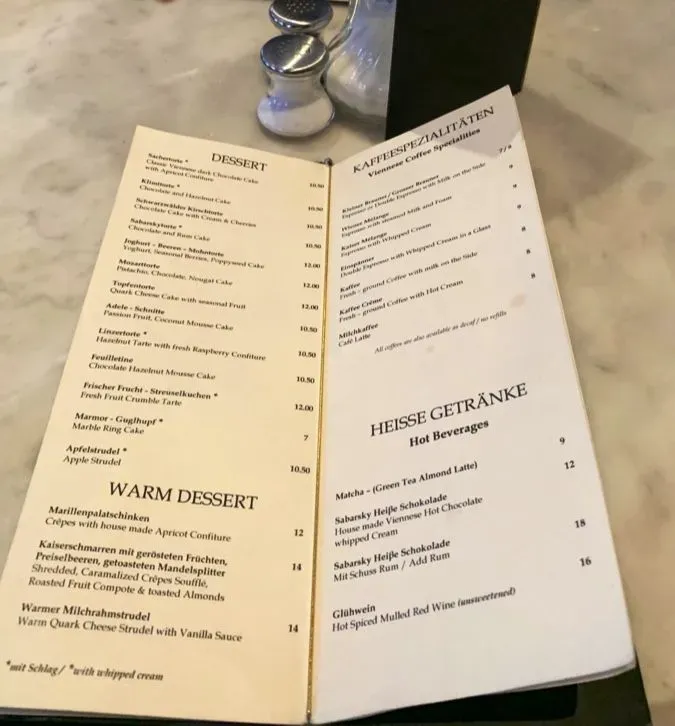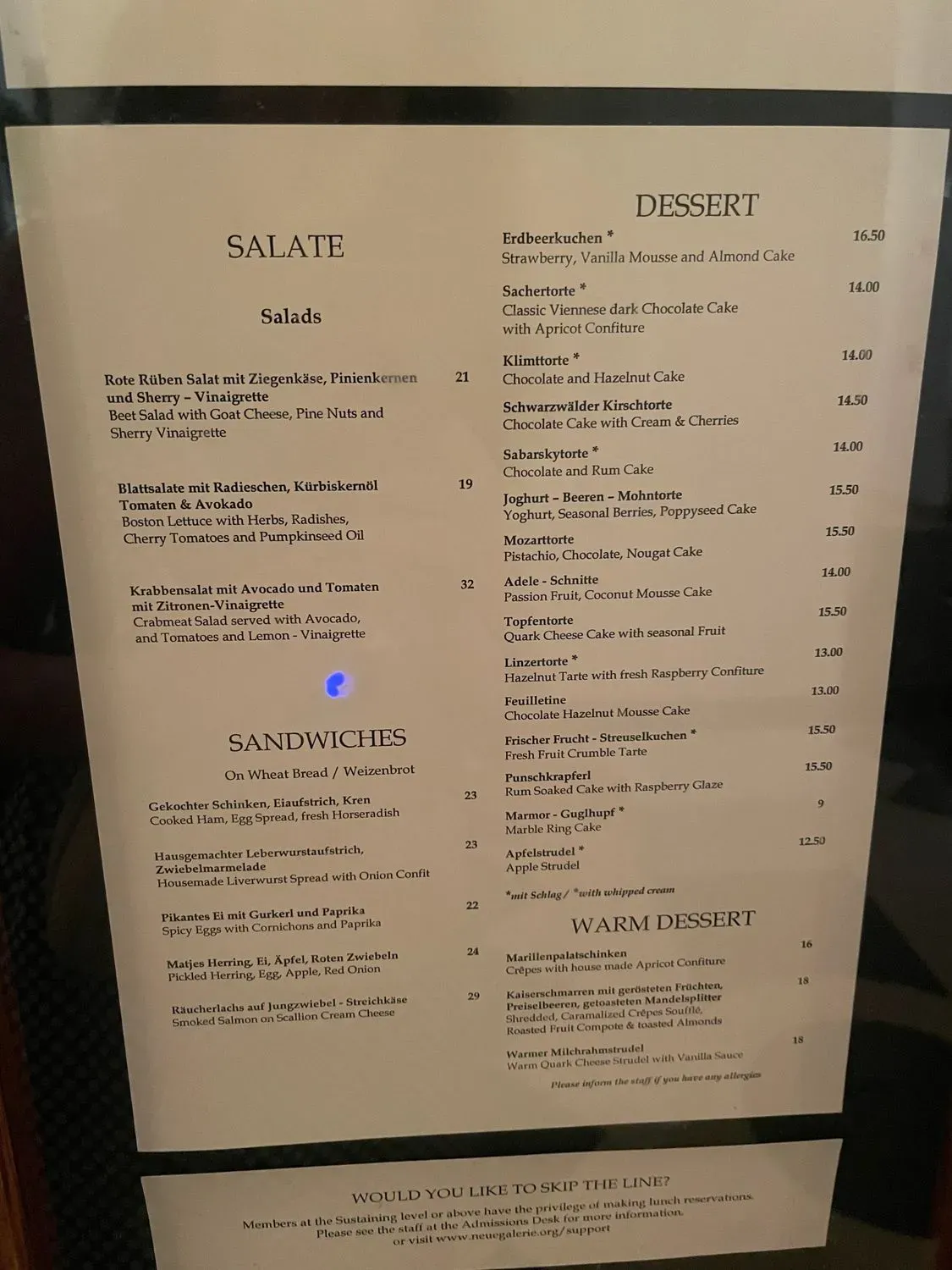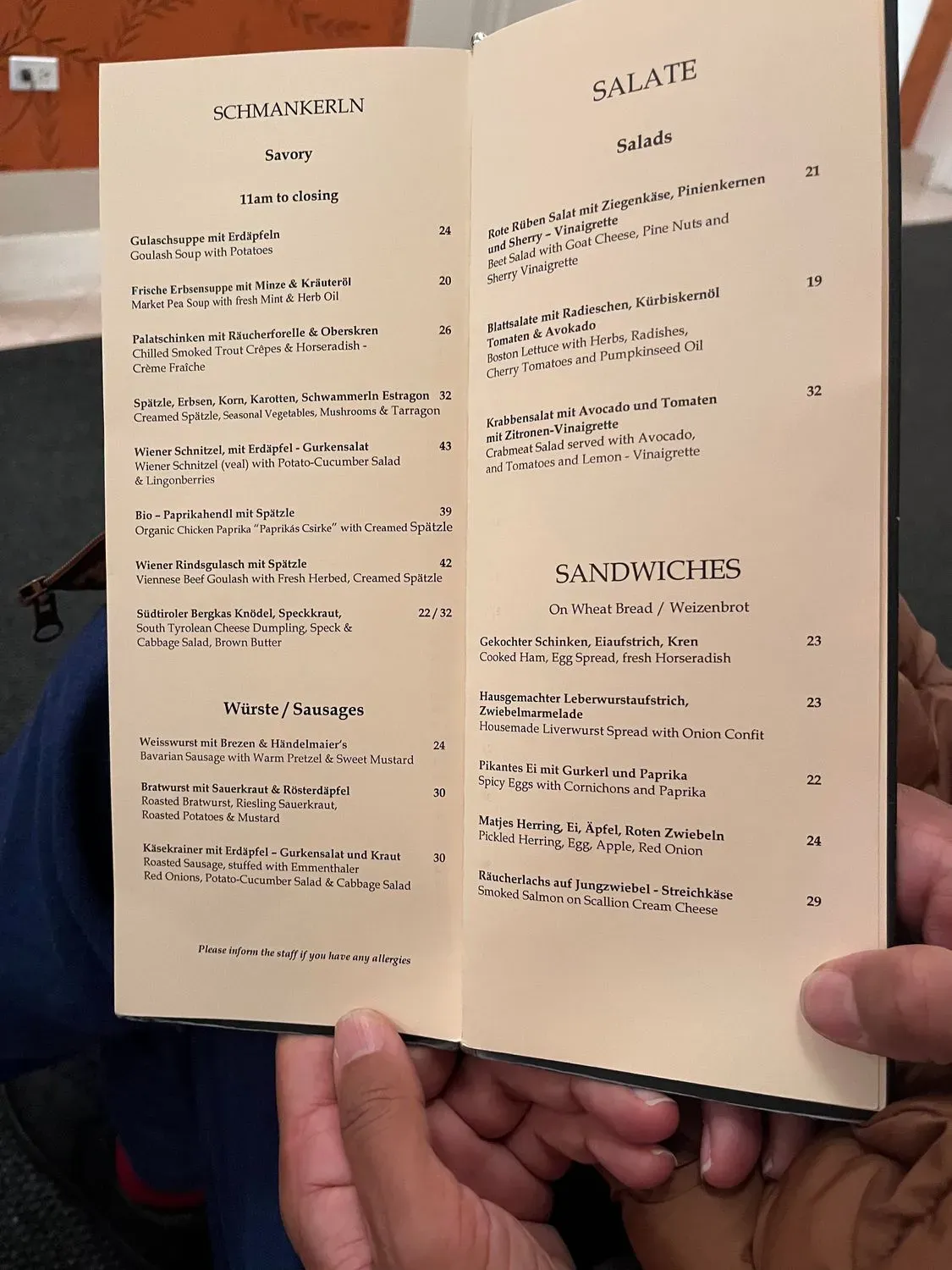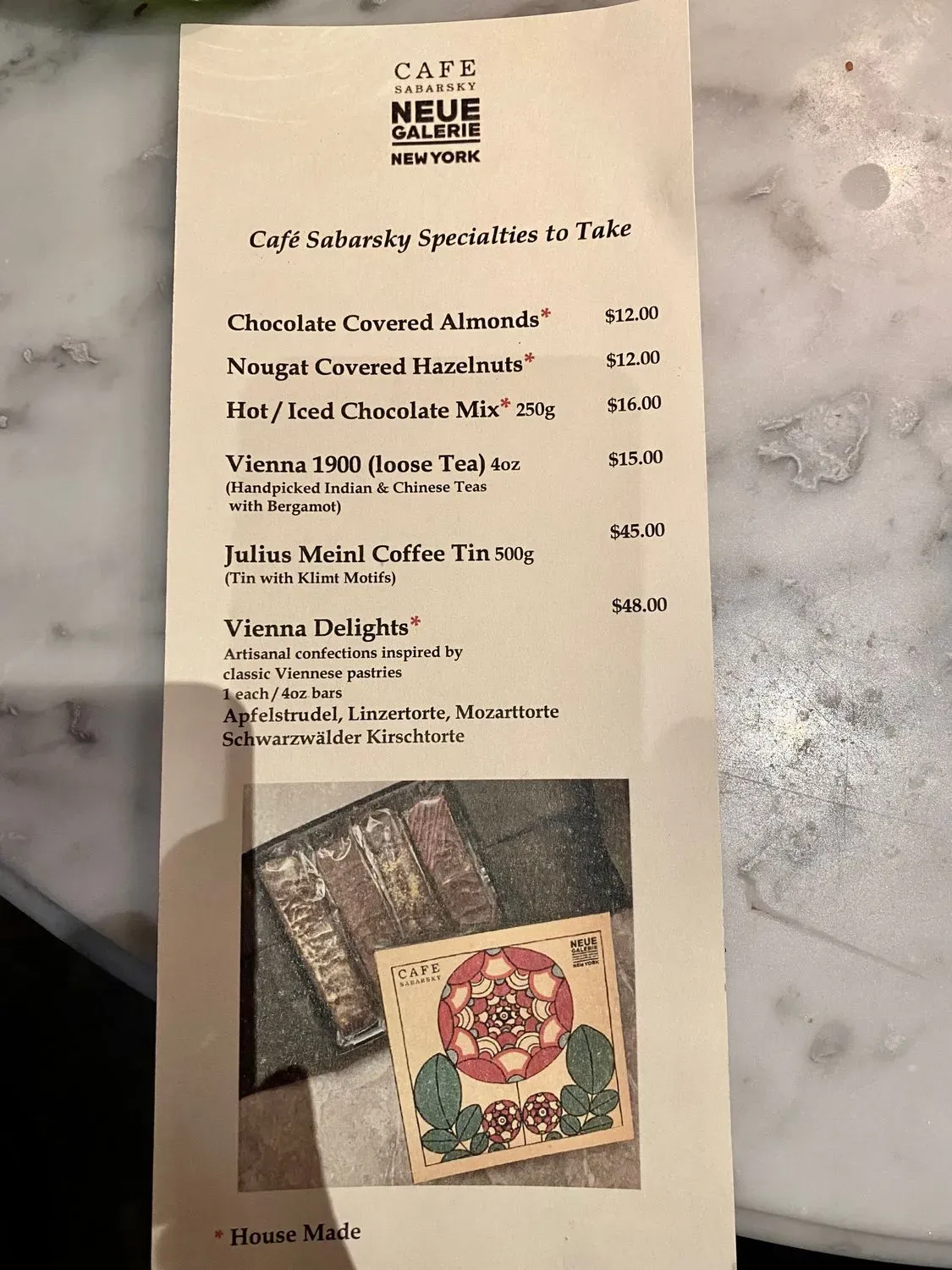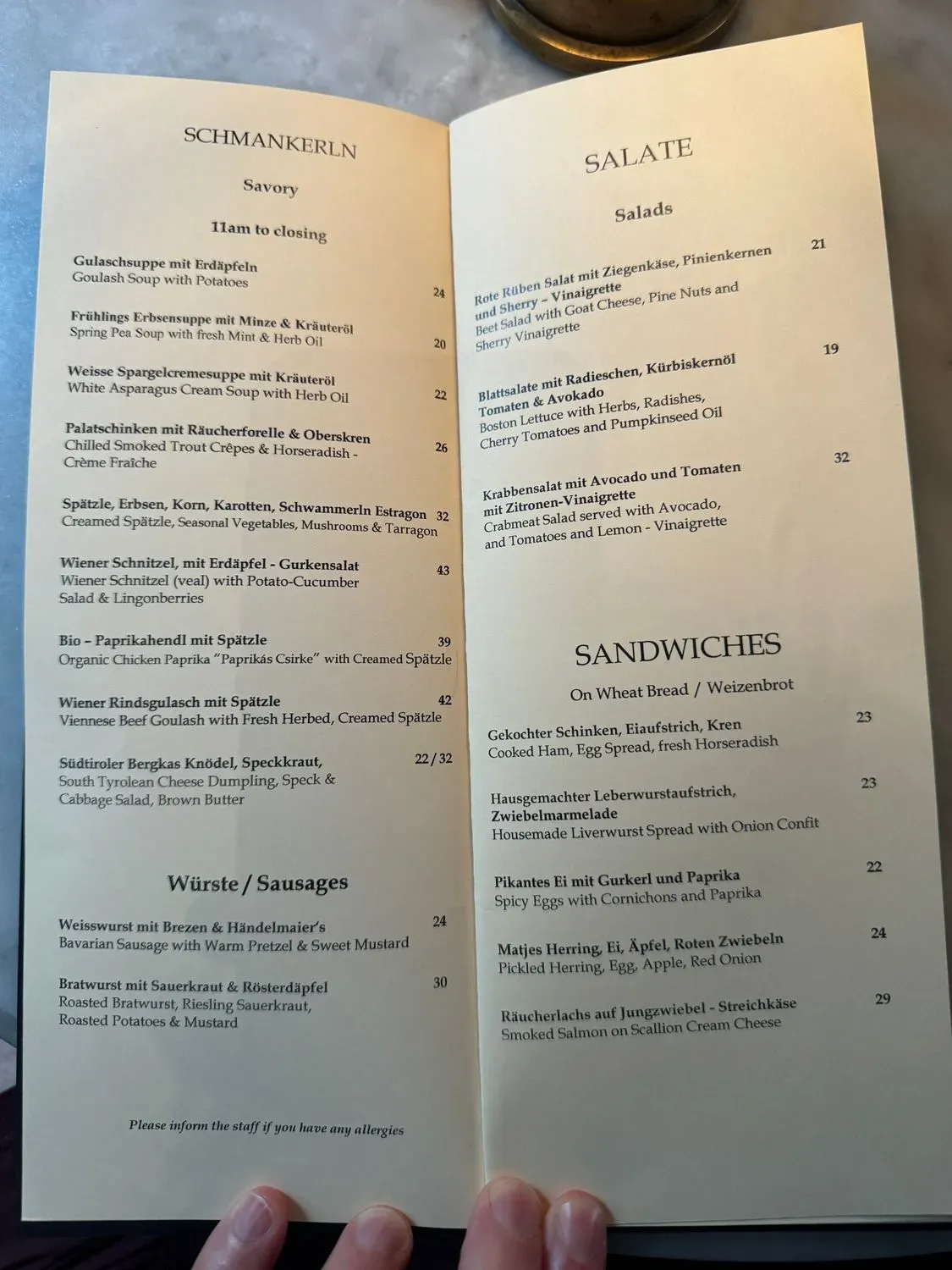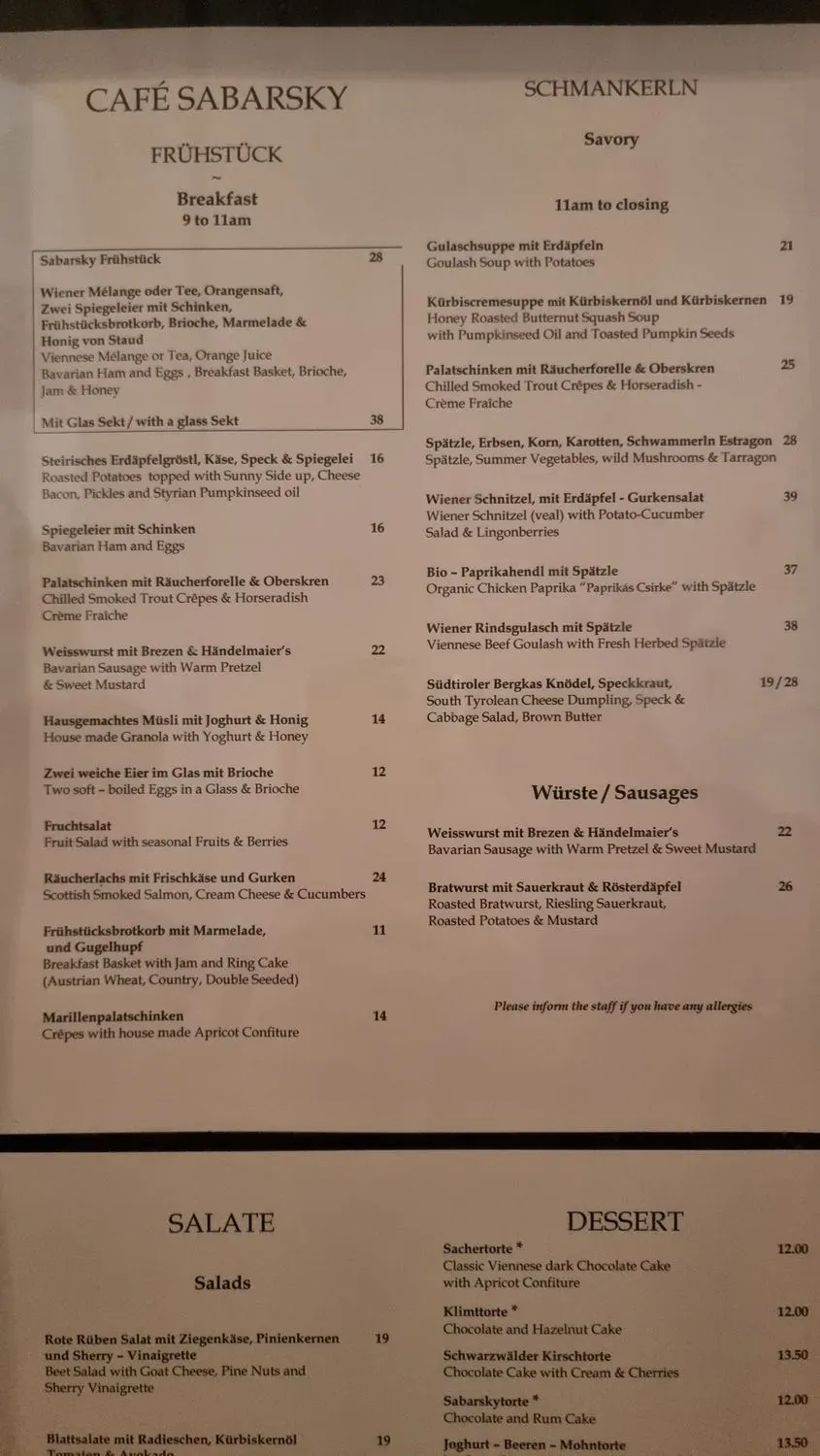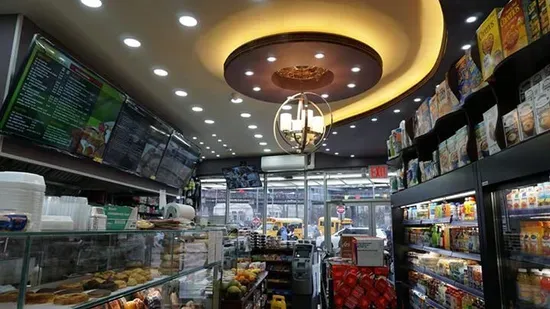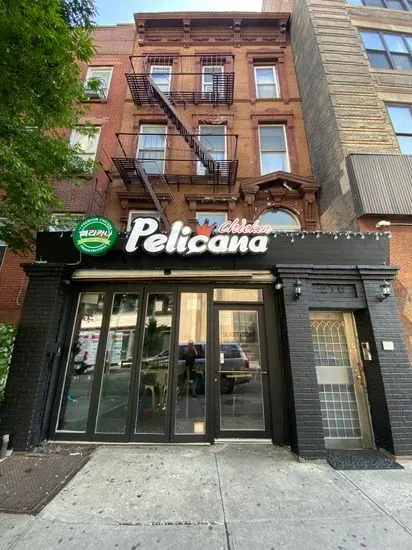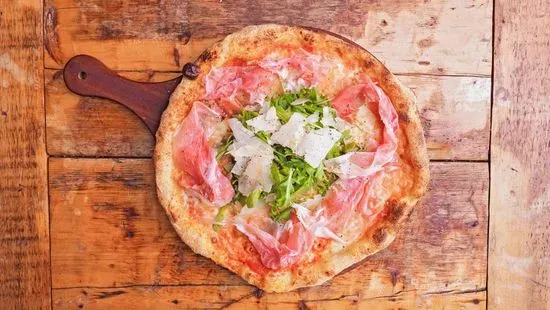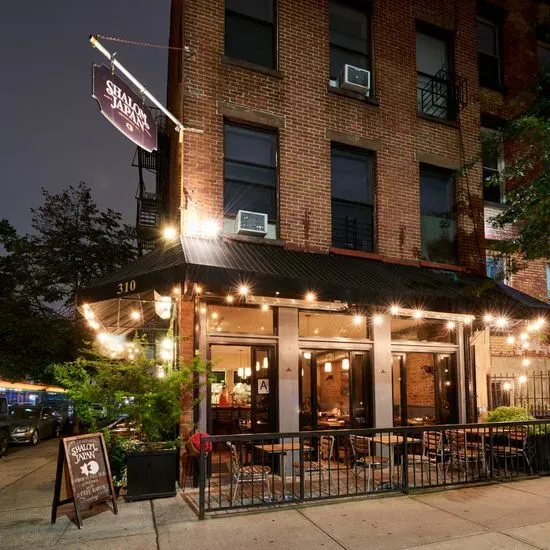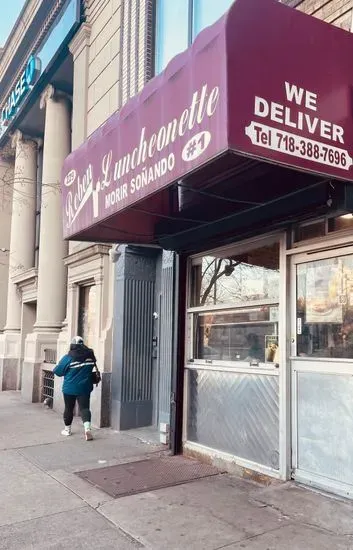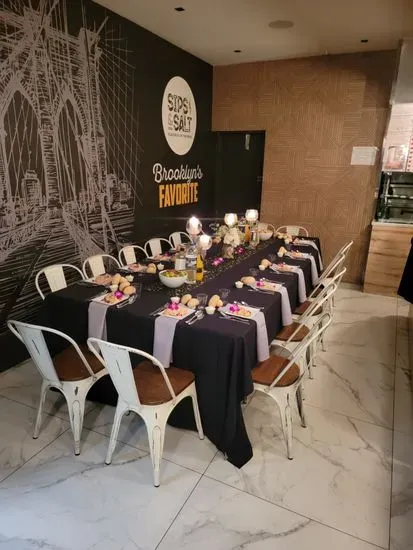Search
Breakfast
- Steirisches Erdäpfelgröstl, Käse, Speck & SpiegeleiRoasted Potatoes topped with Sunny Side up, Cheese Bacon, Pickles and Styrian Pumpkinseed oil$19.00
- Spiegeleier Mit SchinkenBavarian Ham and Eggs$17.00
- Palatschinken Mit Räucherforelle & OberskrenChilled Smoked Trout Crêpes & Horseradish Crème Fraîche$23.00
- Weisswurst Mit Brezen & Händelmaier‘sBavarian Sausage with Warm Pretzel & Sweet Mustard$24.00
- Hausgemachtes Müsli Mit Joghurt & HonigHouse made Granola with Yoghurt & Honey$16.00
- Zwei Weiche Eier Im Glas Mit BriocheTwo soft – boiled Eggs in a Glass & Brioche$14.00
- FruchtsalatFruit Salad with seasonal Fruits & Berries$14.00
- Räucherlachs Mit Frischkäse Und GurkenScottish Smoked Salmon, Cream Cheese & Cucumbers$28.00
- Frühstücksbrotkorb Mit Marmelade, Und GugelhupfBreakfast Basket with Jam and Ring Cake (Austrian Wheat, Country, Double Seeded)$11.00
- MarillenpalatschinkenCrêpes with house made Apricot Confiture$16.00
Savory
- Gulaschsuppe Mit ErdäpfelnGoulash Soup with Potatoes$24.00
- Frühlings Erbsensuppe Mit Minze & KräuterölSpring Pea Soup with fresh Mint & Herb Oil$20.00
- Weisse Spargelcremesuppe Mit KräuterölWhite Asparagus Cream Soup with Herb Oil$22.00
- Palatschinken Mit Räucherforelle & OberskrenChilled Smoked Trout Crêpes & Horseradish - Crème Fraîche$26.00
- Spätzle, Erbsen, Korn, Karotten, Schwammerln EstragonCreamed Spätzle, Seasonal Vegetables, Mushrooms & Tarragon$32.00
- Wiener Schnitzel, Mit Erdäpfel - GurkensalatWiener Schnitzel (veal) with Potato-Cucumber Salad & Lingonberries$43.00
- Bio- Paprikahendl Mit SpätzleOrganic Chicken Paprika “Paprikás Csirke” with Spätzle$39.00
- Wiener Rindsgulasch Mit SpätzleViennese Beef Goulash with Fresh Herbed, Creamed Spätzle$42.00
- Südtiroler Bergkas Knödel, SpeckkrautSouth Tyrolean Cheese Dumpling, Speck & Cabbage Salad, Brown Butter$32.00
Würste
- Weisswurst Mit Brezen & Händelmaier‘sBavarian Sausage with Warm Pretzel & Sweet Mustard$24.00
- Bratwurst Mit Sauerkraut & RösterdäpfelRoasted Bratwurst, Riesling Sauerkraut, Roasted Potatoes & Mustard$30.00
SALATE
- Rote Rüben Salat Mit Ziegenkäse, Pinienkernen Und Sherry – VinaigretteBeet Salad with Goat Cheese, Pine Nuts and Sherry Vinaigrette$21.00
- Blattsalate Mit Radieschen, Kürbiskernöl Tomaten & AvokadoBoston Lettuce with Herbs, Radishes, Cherry Tomatoes and Pumpkinseed Oil$19.00
- Krabbensalat Mit Avocado Und Tomaten Mit Zitronen-VinaigretteCrabmeat Salad served with Avocado, and Tomatoes and Lemon - Vinaigrette$32.00
SANDWICHES
- Gekochter Schinken, Eiaufstrich, KrenCooked Ham, Egg Spread, fresh Horseradish$23.00
- Hausgemachter Leberwurstaufstrich ZwiebelmarmeladeHousemade Liverwurst Spread with Onion Confit$23.00
- Pikantes Ei Mit Gurkerl Und PaprikaSpicy Eggs with Cornichons and Paprika$22.00
- Matjes Herring, Ei, Äpfel, Roten ZwiebelnPickled Herring, Egg, Apple, Red Onion$24.00
- Räucherlachs Auf Jungzwiebel - StreichkäseSmoked Salmon on Scallion Cream Cheese$29.00
DESSERT
- ErdbeerkuchenStrawberry, Vanilla Mousse and Almond Cake$16.50
- SachertorteClassic Viennese dark Chocolate Cake with Apricot Confiture$14.00
- KlimttorteChocolate and Hazelnut Cake$14.00
- Schwarzwälder KirschtorteChocolate Cake with Cream & Cherries$14.50
- SabarskytorteChocolate and Rum Cake$14.00
- Joghurt – Beeren – MohntorteYoghurt, Seasonal Berries, Poppyseed Cake$15.50
- MozarttortePistachio, Chocolate, Nougat Cake$15.50
- Adele - SchnittePassion Fruit, Coconut Mousse Cake$14.00
- TopfentorteQuark Cheese Cake with seasonal Fruit$15.50
- LinzertorteHazelnut Tarte with fresh Raspberry Confiture$13.00
- FeuilletineChocolate Hazelnut Mousse Cake$13.00
- Frischer Frucht - StreuselkuchenFresh Fruit Crumble Tarte$15.50
- PunschkrapferlRum Soaked Cake with Raspberry Glaze$15.50
- Marmor - GuglhupfMarble Ring Cake$9.00
- ApfelstrudelApple Strudel$12.50
MEAL KITS
- ORGANIC CHICKEN PAPRIKASH WITH SPÄTZLEAustrian cuisine is heavily influenced by all the cultures found within the borders of the former Austrian-Hungarian Empire (1867–1918), which spanned throughout Central Europe. Chicken Paprikash originated among the farmers of southern Hungary, who supplied the peppers from which paprika is made, and two towns in the region—Kaloscsa and Szeged—are well-known for their excellent paprika. “Paprikás Csirke Nokedlivel” is one of the most famous variations on the paprika preparations common to Hungarian tables, which found its place in many Viennese cafés and restaurants. MAKES 2 SERVINGS$64.00
- VIENNESE BEEF GOULASHThis dish traces back to the ninth century, and was typically eaten by Hungarian shepherds. Early versions did not include paprika, as this ingredient was not introduced to the Old World until the 16th century. Hungarian sweet paprika is now considered an essential part of the recipe. Goulash is one of the few dishes that actually tastes better on its second day, after it is reheated. Serve with spätzle (Austrian tear-shaped pasta). Enjoy! MAKES 2 SERVINGS$64.00
- ROASTED BRATWURST, RIESLING SAUERKRAUT AND ROASTED POTATOES WITH MUSTARDWhile sausage recipes can be found as early as 228 A.D., and although, some sources list over 40 different varieties of German bratwurst, the first documented evidence of the bratwurst in Germany dates from 1313, in the Franconian city of Nürnberg (Nuremberg). How these sausages are eaten varies by locality, but they are most commonly served with roasted potatoes, sauerkraut, rye bread, and spicy mustar MAKES 2 SERVINGs$42.00
- BAVARIAN WEISSWURST WITH WARM PRETZEL AND SWEET MUSTARDA Weisswurst, literally white sausage, is a traditional Bavarian sausage made from minced veal and pork back bacon. The Weisswurst was created in Munich on February 22, 1857, and has since become a very important part of Bavarian cooking and lifestyle. Legend has it that the Weisswurst was invented by a mistake in 1857, when an innkeeper in Munich ran out of sheep casings for his Bratwürste and in order to feed his hungry guests, used tough and chewy pork casings instead. MAKES 2 SERVINGS$42.00
- SPÄTZLE, MUSHROOMS, CARROTS, PEAS, TARRAGONThe tradition of making “Spätzle” can be traced back to the 18th century, although medieval illustrations are believed to place the pasta at an even earlier date. In 1725, Rosino Lentilio, a councillor and personal physician from Württemberg, concluded that “Knöpflein” and “Spazen” were “all the things that are made from flour.” Since March 2012, Swabian Spätzle and Swabian Knöpfle have been awarded the EU quality seal for “Protected Geographical Indications (PGI)” and are protected throughout Europe as a regional specialty. In order to be able to bear this sign, one of the production stages of the product must have taken place in the respectively defined region of origin MAKES 2 SERVINGS$42.00
CAKES
- SACHERTORTE MIT SCHLAGThe world’s most famous cake, the Sachertorte, is the result of several lucky twists of fate. The first was in 1832, when the Austrian State Chancellor, Prince Klemens Wenzel von Metternich, gave his kitchen staff the task of concocting an extraordinary dessert to impress his special guests. As fortune would have it, the chef had fallen ill that evening, leaving the apprentice chef, then 16-year-old Franz Sacher, to perform this culinary magic trick. Metternich’s parting words to the talented teenager were, “I hope you won’t disgrace me tonight.” Franz Sacher seized the moment and conjured up the confection of a lifetime, the chocolate cake that would go down in history as the ne plus ultra of desserts: the Sachertorte. The cake soon gained a cult following, and was deemed “presentable at court.” From then on, it was a favorite at the Imperial Court and soon went on to win the hearts (and palates) of the world. 2 SERVINGS$24.00
- WIENER APFELSTRUDEL MIT SCHLAGApfelstrudel is a traditional Viennese dessert, a pastry popular in Austria, Germany, the Czech Republic, Italy, and in many other countries in Europe that once belonged to the Austro-Hungarian Empire (1867–1918). The oldest known strudel recipe is from 1697, a handwritten recipe housed in Vienna at the Wienbibliothek im Rathaus. Whether as a type of sweet or savory layered pastry with a filling inside, the strudel gained popularity in the 18th century through the Habsburg Empire. Austrian cuisine was formed and influenced by the cuisines of many different peoples during the centuries of the Habsburg Empire expansion. Strudel is related to baklava, which came to Austria from Turkey via Hungarian cuisine. Apfelstrudel is considered to be the national dish of Austria, along with Wiener Schnitzel and Tafelspitz 2 SERVINGS$24.00
- MOZART TORTEThis torte is named after the classical composer Wolfgang Amadeus Mozart, who was born in Salzburg, Austria. It is hard to pin down a classic recipe for Mozart Torte, as these vary considerably. One thing that is clear is that the original cake was inspired by the dessert Mozartkugeln. Confectioner Paul Fürst first created Mozartkugeln in 1890 in Salzburg. It consists of spheres made out of Viennese nougat, which has a soft, truffle-like consistency, and pistachio marzipan covered in chocolate. Their popularity inspired the Mozart Torte, invented by Michael Prousek in 2005 for Chocolaterie & Grosskonditorei Aïda in Vienna. Although developed more recently than Apfelstrudel and Sachertorte, this delicious cake is a modern classic! SERVINGS$27.00
